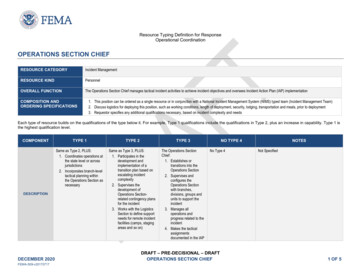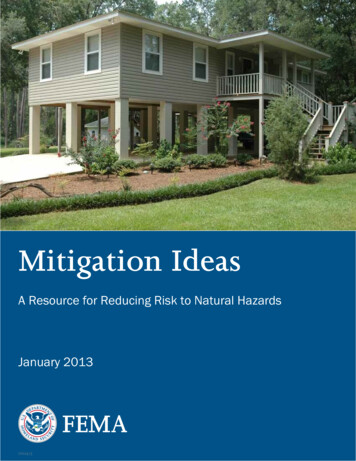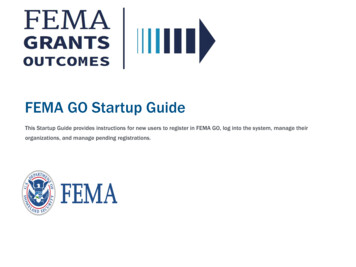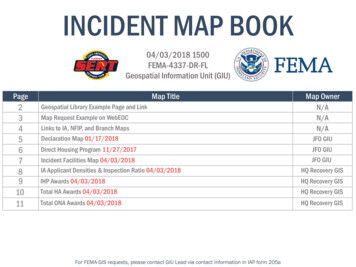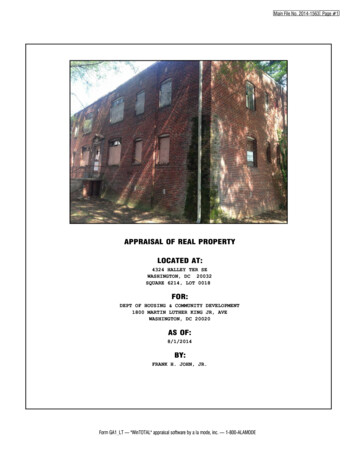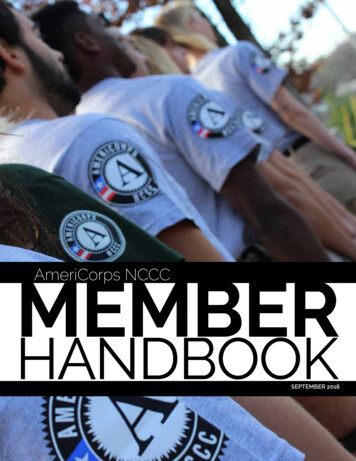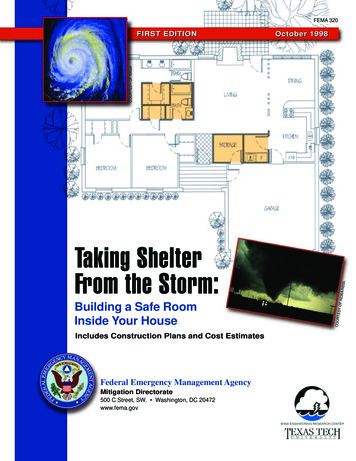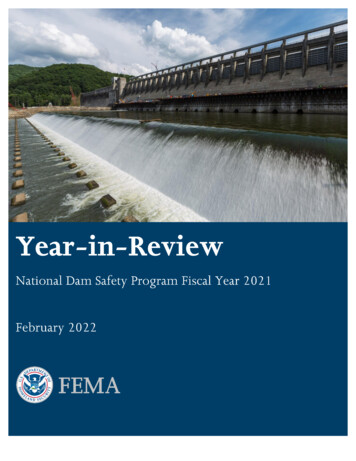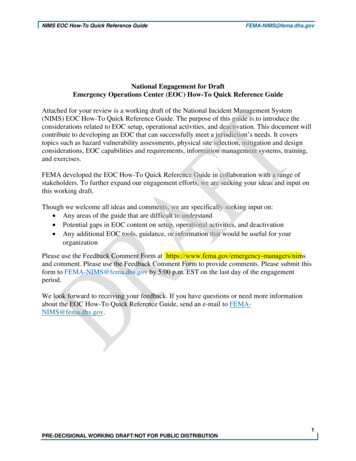
Transcription
Emergency Support Function #6 – Mass Care, Emergency Assistance, Housing, and Human ServicesAnnexESF Coordinator:Department of Homeland Security/FederalEmergency Management AgencyPrimary Agency:Department of Homeland Security/FederalEmergency Management AgencySupport Agencies:Department of AgricultureDepartment of DefenseDepartment of Health and Human ServicesDepartment of Homeland SecurityDepartment of Housing and UrbanDevelopmentDepartment of the InteriorDepartment of JusticeDepartment of LaborDepartment of TransportationDepartment of the TreasuryDepartment of Veterans AffairsGeneral Services AdministrationSmall Business AdministrationSocial Security AdministrationU.S. Postal ServiceAmerican Red CrossCorporation for National and CommunityServiceNational Voluntary Organizations Active inDisasterOther voluntary agency andnongovernmental support organizationsINTRODUCTIONPurposeEmergency Support Function (ESF) #6 – Mass Care, Emergency Assistance, Housing, andHuman Services coordinates the delivery of Federal mass care, emergency assistance, housing,and human services when local, tribal, and State response and recovery needs exceed theircapabilities.AuthoritiesyyyyyyyyRobert T. Stafford Disaster Relief and Emergency Assistance Act (Public Law 93-288), asamendedHomeland Security Act of 2002Homeland Security Presidential Directive 5Post-Katrina Emergency Management Reform Act of 2006Pets Evacuation and Transportation Standards Act of 2006Public Health Service Act, as amendedSocial Security Act of 1935, as amendedAmericans With Disabilities Act of 1990SCOPEThe Department of Homeland Security (DHS)/Federal Emergency Management Agency (FEMA)coordinates and leads Federal resources, as required, to support local, tribal, and Stategovernments and voluntary agencies (VOLAGs) in the performance of mass care, emergencyassistance, housing, and human services missions.January 2008ESF #6 – Mass Care, Emergency Assistance, Housing, and Human Services AnnexESF #6-1
Emergency Support Function #6 – Mass Care, Emergency Assistance, Housing, and Human ServicesAnnexWhen directed by the President, ESF #6 services and programs are implemented to assistindividuals and households impacted by potential or actual disaster incidents. ESF #6 isorganized into four primary functions: Mass Care, Emergency Assistance, Housing, and HumanServices.yMass Care: Includes sheltering, feeding operations, emergency first aid, bulk distributionof emergency items, and collecting and providing information on victims to family members.yEmergency Assistance: Assistance required by individuals, families, and theircommunities to ensure that immediate needs beyond the scope of the traditional “masscare” services provided at the local level are addressed. These services include: support toevacuations (including registration and tracking of evacuees); reunification of families;provision of aid and services to special needs populations; evacuation, sheltering, and otheremergency services for household pets and services animals; support to specializedshelters; support to medical shelters; nonconventional shelter management; coordination ofdonated goods and services; and coordination of voluntary agency assistance.yHousing: Includes housing options such as rental assistance, repair, loan assistance,replacement, factory-built housing, semipermanent and permanent construction, referrals,identification and provision of accessible housing, and access to other sources of housingassistance. This assistance is guided by the National Disaster Housing Strategy.yHuman Services: Includes the implementation of disaster assistance programs to helpdisaster victims recover their nonhousing losses, including programs to replace destroyedpersonal property, and help to obtain disaster loans, food stamps, crisis counseling, disasterunemployment, disaster legal services, support and services for special needs populations,and other Federal and State benefits.POLICIESESF #6 will assist in coordination with impacted local, tribal, and State governments andcommunities without regard to race, color, national origin, religion, nationality, sex, age,disability, limited English proficiency, or economic status.Duplication of effort and benefits will be reduced to the extent possible.ESF #6 will support local, tribal, State, and Federal agencies, voluntary agencies andnongovernmental organizations, and ESF #8 – Public Health and Medical Services in addressingthe functional needs of special needs populations, as defined in the National ResponseFramework (NRF) Glossary. Functional needs may be present before, during, or after anincident in one or more areas, including but not limited to:yyyyyMaintaining ion.Medical care.Individuals in need of additional response assistance may include those who have disabilities,who live in institutional settings, who are elderly, who are from diverse cultures, who havelimited English proficiency or who are non-English speaking, who are children, or who aretransportation disadvantaged.ESF #6-2ESF #6 – Mass Care, Emergency Assistance, Housing, and Human Services AnnexJanuary 2008
Emergency Support Function #6 – Mass Care, Emergency Assistance, Housing, and Human ServicesAnnexThe Federal response community recognizes the varying and special requirements of individualsthat require and utilize the assistance of family members, personal assistants, and/or serviceanimals and is committed to ensuring that the physical and mental health needs of theseindividuals are appropriately addressed and that the individuals and assistance providersremain together to the maximum extent possible during evacuation, transport, sheltering, orthe delivery of other services. Service animals shall be treated as required by law (e.g., theAmericans With Disabilities Act (ADA) of 1990).The Federal response community recognizes the varying and special requirements of childrenand is committed to ensuring that the physical and mental health needs of children will beappropriately addressed, and that children will remain with their families or caregivers to themaximum extent possible during evacuation, transport, sheltering, or the delivery of otherservices.CONCEPT OF OPERATIONSGeneralDHS/FEMA will coordinate Federal response and recovery operations in close coordination withlocal, tribal, and State governments, VOLAGs, and the private sector. ESF #6 assistance ismanaged and coordinated at the lowest possible organizational level—e.g., the Joint Field Office(JFO) and the Regional Response Coordination Center (RRCC). Only requests that cannot befilled or issues that cannot be resolved at the RRCC/JFO levels are elevated to the NationalResponse Coordination Center (NRCC) ESF #6 Branch for resolution.Initial response activities will focus on immediate needs of victims.Recovery efforts are initiated concurrently with response activities.ORGANIZATIONHeadquarters-Level ESF #6 Support – National Response Coordination Center (NRCC) ESF #6BranchWhen activated, ESF #6 reports to the NRCC Operations Section.The NRCC ESF #6:yCoordinates and resolves national-level ESF #6 issues.yAddresses RRCC requests for additional ESF #6 support teams and de-conflicts multiplerequests for limited resources.yContacts and activates national-level ESF #6 support agencies, as required.yProvides consolidated reports on mass care, emergency assistance, housing, and humanservices activities to the NRCC Planning Section for inclusion in the national situation report.yDistributes ESF #6 information to ESF #6 support agencies, as appropriate.January 2008ESF #6 – Mass Care, Emergency Assistance, Housing, and Human Services AnnexESF #6-3
Emergency Support Function #6 – Mass Care, Emergency Assistance, Housing, and Human ServicesAnnexHeadquarters-Level ESF #6 Support – National Processing Service Centers (NPSCs)NPSCs provide registration intake services and process disaster assistance applications,including eligibility determinations for FEMA Individuals and Households Program. The NPSCsare managed by DHS/FEMA Individual Assistance Division.DHS/FEMA will ensure that individuals and families evacuated or sheltered are afforded accessto Federal disaster assistance, by providing access to the DHS/FEMA registration intake system.This includes access for individuals who may need alternate formats, sign languageinterpreters, or information presented in a language other than English.Disaster victims may register for Disaster Assistance by phone, Internet, or in person at MobileRegistration Intake Centers (MRICs).State-Level ESF #6 SupportThe State designates an official(s) to coordinate with Federal mass care, emergency assistance,housing, and human services assistance. This official(s) will serve as the principal point(s) ofcontact with the RRCC ESF #6 Branch.Regional-Level ESF #6 Support – Regional Response Coordination Center (RRCC) ESF #6BranchUpon activation, the RRCC ESF #6 Branch:yAssesses the situation and identifies resource requirements in close coordination with Statecounterparts.yConvenes regional ESF #6 support agencies.yProvides ESF #6 liaisons to the Incident Management Assistance Team, JFO, and otherDHS/FEMA or State facilities, as appropriate.yCoordinates ESF #6 Federal resource requests with Federal departments and agencies atthe regional level. Only requests that cannot be filled or issues that cannot be resolved atthe RRCC/JFO levels are elevated to the NRCC for resolution.yContacts and activates regional ESF #6 support agencies, as required.yProvides updated consolidated reports on mass care, emergency assistance, housing, andhuman services activities to the RRCC Planning Section for inclusion in regional situationreports.yDistributes ESF #6 information to ESF #6 support agencies, as appropriate.yProvides technical assistance to designated State lead agencies, as needed.As the primary Federal agency for ESF #6, DHS/FEMA will identify initial needs and ensure thatthe requested and necessary support is in place for the ESF #6 support agencies to executetheir missions to include: requests for assistance, activation of pre-scripted missionassignments, and issuance of mission assignments.ESF #6-4ESF #6 – Mass Care, Emergency Assistance, Housing, and Human Services AnnexJanuary 2008
Emergency Support Function #6 – Mass Care, Emergency Assistance, Housing, and Human ServicesAnnexLiaisons from Federal support agencies and VOLAGs may assist the ESF #6 Branch at the RRCCand JFO, as necessary.Field-Level ESF #6 Support – Joint Field Office (JFO) ESF #6 BranchOnce established, the JFO ESF #6 Branch:ySupports local, tribal, and State governments and VOLAGs in the provision of mass care,emergency assistance, housing, and human services.yProvides consolidated reports on mass care, emergency assistance, housing, and humanservices activities to the JFO Planning Section for inclusion in field Incident Action Plans andsituation reports.yDistributes ESF #6 information to ESF #6 support agencies, as appropriate.yReports on current mass care services and activities using data provided by the AmericanRed Cross and local, tribal, State, Federal, and other voluntary agencies.yAnticipates and identifies future requirements in coordination with local, tribal, State, andother Federal agencies.yMonitors State requirement for the use of Federal-facilitated reunification systems (e.g., theNational Emergency Family Registry and Locator System (NEFRLS) and the NationalEmergency Child Locator Center (NECLC)).yFacilitates the process by which VOLAGs providing mass care services in affected State(s)request resource support from the Federal Government and the designated State leadagency for mass care.yCoordinates with local, tribal, State, Federal, and voluntary agencies for additional sheltercapacity, including accessible shelters.yDevelops an initial housing strategy, in coordination with local, tribal, and State leadership,DHS/FEMA Headquarters, and Federal support agencies.yCoordinates with local, tribal, and State governments and VOLAGS to depopulate shelters asrequired and, when possible, plan for the return of evacuees, including evacuees withspecial needs, to their pre-disaster locations.Staff from the ESF #6 primary and support agencies remain activated through the initial phaseof recovery activities to ensure all response issues are addressed and to support the transitionof related issues and responsibilities from mass care to housing.FUNCTIONAL AREASMass CareEach State designates a lead State agency for mass care that works at the direction of theGovernor to ensure mass care services are provided to the affected population.January 2008ESF #6 – Mass Care, Emergency Assistance, Housing, and Human Services AnnexESF #6-5
Emergency Support Function #6 – Mass Care, Emergency Assistance, Housing, and Human ServicesAnnexLocal, tribal, and State governments in coordination with voluntary organizations will provideshelter, feeding, bulk distribution, emergency first aid, and disaster welfare information (DWI).DHS/FEMA, in its role as the ESF #6 lead, coordinates closely with the State to provide Federalmass care resources to support and augment mass care capabilities, when requested by theState.yShelter: Emergency shelter includes the use of designated shelter sites in existingstructures within the affected area(s), as well as additional sites designated by localgovernment. Shelter sites shall be selected to maximize accessibility for individuals withdisabilities, whenever possible.yFeeding: Feeding includes a combination of fixed sites, mobile feeding units, and bulkdistribution sites.yBulk Distribution: Bulk distribution includes distribution of emergency relief items to meeturgent needs through sites established within the affected area(s). These sites are used todistribute food, water, or other commodities in coordination with local, tribal, State, andFederal governmental entities and voluntary agencies and other private-sectororganizations.yEmergency First Aid: Emergency first aid includes provision of basic first aid at mass carefacilities and designated sites and referral to appropriate medical personnel and facilities.yDisaster Welfare Information: DWI includes services related to the provision ofinformation about individuals residing within the affected area to immediate family membersoutside the affected area. It may also include services related to the reunification of familymembers within the affected area.ESF #6 may provide the following support to local, tribal, State governments, and VOLAGs, asrequested by the State.yEmergency Feeding and Distribution: ESF #6 will work in concert with Department ofAgriculture (USDA) Food and Nutrition Service (FNS) and with local, tribal, and Stategovernments and VOLAGs to distribute food and food supplies when their capabilities are inneed of additional resources from the Federal Government, as determined by the State.This may include support to private-sector feeding operations, securing food commodities,developing feeding plans, and obtaining warehouse space.yDistribution of Emergency Relief Items: ESF #6 will support local, tribal, State, andVOLAG points of distribution (PODs) for distribution of emergency relief items. Support mayalso include transportation, technical support, and other mission-critical items.Emergency AssistanceDHS/FEMA coordinates resources and emergency assistance in support of local, tribal, andState governments, VOLAGs, and the private sector to augment their mass care responseactivities, as requested or directed.yMass Evacuation: The ESF #6 Branch, at the lowest available organizational level (e.g.,JFO, RRCC, NRCC), may provide staff to support local, tribal, and State authorities withmass evacuation.ESF #6 mass evacuation activities and requirements are identified and addressed in theMass Evacuation Incident Annex to the NRF.ESF #6-6ESF #6 – Mass Care, Emergency Assistance, Housing, and Human Services AnnexJanuary 2008
Emergency Support Function #6 – Mass Care, Emergency Assistance, Housing, and Human ServicesAnnexyFacilitated Reunification: When a mass evacuation process requires Federal support,DHS/FEMA will track information on individuals and families in an effort to assist with thereunification of separated family members. Tracking, locating, registering, and reunitingevacuees and survivors are activities performed at local, State, and Federal levels.yHousehold Pets and Service Animals: ESF #6 ensures coordination of mass careservices to provide for the safety and well-being of household pets and service animalsduring evacuations and sheltering. ESF #8 and ESF #11 - Agriculture and NaturalResources will ensure support to ESF #6 through an integrated response. ESF #11, underESF #6, coordinates Federal support services for household pets and service animals duringdisasters. When requested by the State, ESF #6 will collaborate with ESF #8 and ESF #11to ensure coordination of support to household pets and service animals.The Federal response community recognizes the varying and special requirements ofindividuals that require and utilize service animals and is committed to ensuring that thephysical and mental health needs of these individuals are appropriately addressed and thatthe individuals and service animals remain together to the maximum extent possible duringevacuation, transport, sheltering, or the delivery of other services and in accordance withthe requirements of the ADA.yGeneral, Specialized, Medical, and Nonconventional Shelters: ESF #6 will provideFederal assistance, resources, and technical assistance in support of local, tribal, and Stategovernments, VOLAGs, and host States when conventional and nonconventional congregatecare systems and shelter-in-place activities are in need of additional resources from theFederal Government, as determined by the State. Congregate care facilities are accessibleto individuals with disabilities, whenever possible.Nonconventional sheltering may include:yyyyHotels, motels, and other single-room facilities.Temporary facilities such as tents, prefab module facilities, trains, and ships.Specialized shelters and functional and medical support shelters (through coordinationwith ESF #8 and the affected or host State).Support for other specialized congregate care areas that may include respite centers,rescue areas, and decontamination processing centers.National Shelter SystemThe National Shelter System (NSS) is a web-based comprehensive database that providesinformation for shelters posted to the NSS during response to disasters and emergencies.Reports from the NSS will detail the location and capacities of shelters (evacuation, general,ADA compliant, pet friendly, medical, etc.) open, on stand-by, or closed. The information inthe NSS is submitted by the local, tribal, State, and VOLAG entities operating theseshelters.ySupport to Unaffiliated Volunteers and Unsolicited Donations: The DonationsManagement Unit at DHS/FEMA Headquarters supports tribal and State governmentmanagement of volunteers and donated goods, as required.The procedures, processes, and activities for Federal assistance to support spontaneousvolunteers and unsolicited donations are defined in the Volunteer and DonationsManagement Support Annex.January 2008ESF #6 – Mass Care, Emergency Assistance, Housing, and Human Services AnnexESF #6-7
Emergency Support Function #6 – Mass Care, Emergency Assistance, Housing, and Human ServicesAnnexFederal support to volunteer and donations management may include the following:yyyyA database system to manage and record offers of donated goods and services.Warehouse support for housing unsolicited donated goods.Coordination of unsolicited private and international donations.Voluntary Agency Coordination: ESF #6 works in concert with local, tribal, and Stategovernments, VOLAGs, faith-based organizations, and the private sector to facilitate aninclusive, multiagency, communitywide, and coordinated response and recovery effort.ESF #6 works with local officials, private nonprofit organizations, the State, and others toestablish a long-term recovery strategy to address the unmet needs of individuals andfamilies, including those with special needs. ESF #6 may also coordinate with NationalVoluntary Organizations Active in Disaster (National VOAD) and international relieforganizations to support the efforts of local voluntary agencies and faith-basedorganizations.ESF #6 coordinates among nontraditional and newly formed voluntary agencies, existingsocial service agencies, and other government agencies with formal coalitions such as VOADand Long-Term Recovery Committees. Nontraditional voluntary agencies include disasterresponse or recovery service providers that have not been involved with the planning andcoordination efforts prior to a particular event. New voluntary agencies include groups thatform in response to a particular event.HousingThe National Disaster Housing Strategy defines the full scope of options for disaster housingassistance, including:yTemporary Roof Repair: Quick repairs to damaged roofs on private homes. Thisassistance allows residents to return to and remain in their own homes while performingpermanent repairs.yRepair Program: Financial assistance to homeowners for repair of their primary residence,utilities, and residential infrastructure.yReplacement Program: Financial assistance issued to victims to replace their destroyedprimary residence.yExisting Housing Resources: A centralized location for identified available housingresources from the private sector and other Federal agencies (i.e., Department of Housingand Urban Development (HUD), Department of Veterans Affairs (VA), and USDAproperties).yRental Assistance: Financial assistance issued to individuals and families for rental oftemporary accommodations.yNoncongregate Facilities: Facilities that provide private or semiprivate accommodations,but are not considered temporary housing (e.g., cruise ships, tent cities, militaryinstallations, school dorm facilities, or modified nursing homes).yTransportation to Other Locations: Assistance to relocate individuals and familiesoutside of the disaster area where short- or long-term housing resources are available.Transportation services may include return to the pre-disaster location.ESF #6-8ESF #6 – Mass Care, Emergency Assistance, Housing, and Human Services AnnexJanuary 2008
Emergency Support Function #6 – Mass Care, Emergency Assistance, Housing, and Human ServicesAnnexyPermanent Construction: Direct assistance to victims and families of permanent orsemipermanent housing construction.yDirect Financial Housing: Payments made directly to landlords on behalf of disastervictims.yHotel/Motel Program: Temporary accommodations for individuals and families intransition from congregate shelters or other temporary environments, but unable to returnto their pre-disaster dwelling.yDirect Housing Operations: Provision of temporary units, usually factory-built. Thisoption is utilized only when other housing resources are not available. Units will beappropriate to the community needs and include accessible units.yHousing Resources are available from the private sector, FEMA, and other Federalagencies (as described below).ySmall Business Administration (SBA) Disaster Loan Programy Provides low-interest, long-term disaster loan assistance for qualified homeownersand renters, nonagricultural businesses of all sizes, and nonprofit organizations tofund the repair and replacement of disaster-damaged property.y Provides loan funds that also may include money for such things as relocation,mitigation, refinancing of existing liens, code-required upgrades, and one-yearinsurance premiums.yDepartment of Housing and Urban Development (HUD)y Provides access to and information on available habitable housing units, includinghousing units accessible to individuals with disabilities, owned, or in HUD possession,within or adjacent to the incident area for use as temporary housing.y Ensures that disaster victims who were receiving Section 8 Rental Assistancevouchers prior to the disaster are reintegrated into that program.y Provides available HUD staff to assist when needed with mass care and housingoperations.y When requested and funded by FEMA, administers the Disaster Housing AssistanceProgram for eligible applicants.y Provides housing resources for individuals certified as eligible for long-term housing.y Provides access to housing counseling services.y Provides enforcement of the Fair Housing Act and compliance with other civil rightsstatutes.yUSDA – Rural Development (RD)As part of the National Disaster Housing Strategy:y Provides information (location, type, owners, and/or management service) on USDAfinanced, currently available, habitable housing units that are not under lease orunder agreement of sale.y Provides available USDA (RD) staff to assist when needed with ESF #6.y Provides Letters of Priority Entitlement allowing the holder of the letter (identifiedevacuee and/or victim) to go to the top of any USDA MF 515 or 514 waiting lists forplacement in USDA-financed housing.y Assists eligible recipients to meet emergency housing assistance needs resultingfrom Presidentially declared emergencies or major disasters.January 2008ESF #6 – Mass Care, Emergency Assistance, Housing, and Human Services AnnexESF #6-9
Emergency Support Function #6 – Mass Care, Emergency Assistance, Housing, and Human ServicesAnnexyVAy Provides available facilities suitable for mass shelter.y Provides assistance to veterans affected by disasters to help them avoid defaultingon existing home mortgages and/or foreclosure on their homes, as well as assistancefor veterans with disabilities to retrofit their homes with necessary accessibilitymeasures (e.g., wheelchair ramp).y Develops and maintains plans to make available housing assets that are habitable, towhich VA has title and possession, for use by survivors in catastrophic disasters.Human ServicesHuman Services provides assistance to address the nonhousing needs of individuals andfamilies. This assistance falls into the following categories:yCora Brown Fund – DHS/FEMA: The Cora Brown Fund is used for uninsured or underinsured disaster-related needs of individuals or families who are unable to obtain adequateassistance from other local, tribal, State, and Federal government programs or fromvoluntary agencies. The fund is not intended to replace or supersede those programs;therefore, if assistance is available from another source, the Cora Brown Fund may not beused. Awards from this fund may be granted only at the discretion of FEMA.yCrisis Counseling and Training – FEMA/Substance Abuse and Mental HealthServices Administration (SAMHSA): The Crisis Counseling Assistance and TrainingProgram provides immediate, short-term crisis counseling services. The program helpsrelieve grieving, stress, or mental health problems caused or aggravated by a disaster or itsaftermath. Assistance provided is short term and is at no cost to the disaster victim.yOther Needs Assistance (ONA) – DHS/FEMA: Awards help with medical, dental,funeral, personal property, transportation, moving and storage, and other expensesauthorized by law (for uninsured or underinsured eligible applicants).yDisaster Case Management – FEMA/Department of Health and Human Services(HHS): ESF #6 provides case management services, including financial assistance, throughgovernment agencies or qualified nonprofits to eligible individuals. Case managementensures that a sequence of delivery is followed to streamline assistance, prevent duplicationof benefits, and provide an efficient referral system.yHHSy Expedites claims for new Federal benefits.y Ensures continuity of services to beneficiaries, such as Medicaid, Temporary Assistanceto Needy Families, Child Care, etc.y Supports States hosting relocated populations by extending existing programs andbenefits or taking other actions as needed, consistent with program authorities.y Provides support and consultation to the primary agency in the development andprovision of case management services, to include advocacy services.y Provides public health and medical support under ESF #8.yVictims of Crime Assistance – Department of Justice (DOJ): Supports local, tribal,State, and Federal assistance to crime victim compensation in incidents resulting fromterrorism or acts of criminal violence, as appropriate.ESF #6-10ESF #6 – Mass Care, Emergency Assistance, Housing, and Human Services AnnexJanuary 2008
Emergency Support Function #6 – Mass Care, Emergency Assistance, Housing, and Human ServicesAnnexyDisaster Unemployment Assistance (DUA) – Department of Labor (DOL):Administered by the impacted State, DUA provides financial assistance to individuals whoseemployment or self-employment has been lost or interrupted as a direct result of a majordisaster declared by the President, and who are not covered by regular unemploymentinsurance.yDepartment of the Treasury – Alcohol and Tobacco Tax and Trade Bureau (TTB):Provides Federal alcohol and tobacco excise tax refunds to businesses that have lost assetsin a disaster.yDepartment of the Treasury – Internal Revenue Service (IRS): Provides taxcounseling and assistance to taxpayers whose property has been damaged or lost in afederally declared disaster area.yDepartment of the Treasury – Bureau of the Public Debty Assists disaster victims by expediting replacement or redemption of U.S. Savings Bonds.y May waive the minimum holding period for Series EE and I Savings Bonds presented toauthorized paying agents for redemption.yVeterans Assistance Program –VAy Provides insurance settlements, adjustments to home mortgages, and death benefits.y Ensures continuity of services, such as pensions, to beneficiaries.ySocial Security Administration (SSA)y Provides Social Security Disability, Social Security Retirement, Social Securit
Emergency Support Function #6 - Mass Care, Emergency Assistance, Housing, and Human Services . disability, limited English proficiency, or economic status. . services activities to the NRCC Planning Section for inclusion in the national situation report. y Distributes ESF #6 information to ESF #6 support agencies, as appropriate. .
